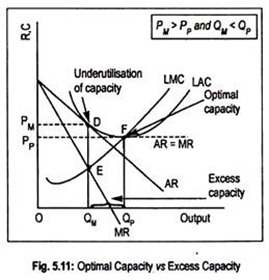This article will help you to learn about the difference between perfect competition and monopoly.
Difference between Perfect Competition and Monopoly
1. Differences in Market Conditions:
In perfect competition there are innumerable numbers of sellers who cannot change the market price of the commodity. They behave as ‘price- takers’. On the other hand, a monopoly firm—a firm or an industry of a single seller—can alter the price of the product.
Under perfect competition, a product is homogeneous. Monopoly product may or may not be homogeneous. Entry (and exit) is free under perfect competition, while entry is blocked under monopoly.
2. P = MR vs. P > MR:
Due to product homogeneity the demand curve (P = AR) faced by a competitive firm is perfectly elastic. Further, AR curve coincides with the MR (i.e., AR = MR) curve since every firm behaves as a ‘price-taker’. In monopoly, demand curve or AR curve is downward sloping. MR curve is also downward sloping and lies below AR curve, i.e., AR > MR.
3. P = AR = MR = MC vs. P = AR > MR = MC:
ADVERTISEMENTS:
A competitive firm reaches equilibrium when MC is equal to MR. Since AR = MR, the equilibrium condition of a competitive firm can be written as MC – MR = AR = P. But, in monopoly, since AR > MR, the equilibrium condition becomes MC = MR > AR – P.
4. Equilibrium and Cost Conditions:
Only when MC is rising equilibrium is possible under perfect competition. A competitive firm fails to reach equilibrium if MC is falling or MC is constant because of the non-fulfilment of SOC for equilibrium. Monopoly equilibrium is consistent with rising, falling and constant MC, provided the slope of MC is greater than the slope of MR.
5. Optimal Capacity vs. Excess Capacity:
A competitive firm always operates at the lowest point of its AC curve. This means that the firm produces at an optimum cost. In the long run, as a competitive firm earns only normal profit (because of free entry and exit), P = minimum AC. That is to say, in the long run, competitive equilibrium occurs when P = AR = MR MC = minimum AC. This means optimal utilization of resources.
A monopoly firm, on the other hand, does not operate at the lowest point of its AC curve. Because of the nature of the demand curve, a monopoly firm operates somewhere to the left of the minimum point of long run AC curve. This means under-utilization of monopoly plant or wastage of resources.
ADVERTISEMENTS:
That is why price charged by a monopolist is higher than the price charged by a competitive firm and output is smaller under monopoly than under perfect competition. Further, in the long run, a monopoly firm may earn abnormal profit. Fig. 5.11 demonstrates this difference.
Demand curve of a competitive firm is represented by the horizontal AR – MR curve. A monopolist’s demand curve and the corresponding marginal revenue curve are downward sloping, represented by AR and MR curves, respectively.
As far as perfect competition is concerned, equilibrium occurs at point F where AR = MR = LMC = minimum point of LAC. Corresponding to this equilibrium point, equilibrium output of a competitive firm is OQP. Equilibrium price is OPP.
ADVERTISEMENTS:
On the other hand, monopoly equilibrium is defined by point E, where LMC = MR < AR = LAC. The monopolist now produces OQM and sells it at the price OPM. It is quite clear that the monopoly price (OPM) is higher than the competitive price (OPP) while monopoly output (OQM) is lower than the competitive output (OQP).
Since the monopolist does not produce at the minimum point of his AC curve, output is less compared to perfect competition.
Here, our monopolist operates at point D rather than at F on the LAC curve. This suggests that the monopolist operates at the sub-optimal scale (i.e., falling part of LAC). Had resources been fully utilized the firm would have operated at point F on the LAC curve.
Such full or optimum utilization of resources is possible only under perfect competition. So, an ideal allocation of resources results in a larger output. The distance QMQP measures ‘negative excess capacity of a monopoly business’.
Perfect competition is, thus, an ideal market in the sense that resources are optimally utilized. This results in larger output and lower price of the product. Social welfare is, thus, maximized under perfect competition.
There occurs a misallocation of resources in monopoly resulting in ‘negative excess capacity’. A monopoly market produces less than its potentiality. Society is, thus, deprived in the form of smaller output. A consumer is exploited by a monopolist since a higher price is charged.
i. Profit:
A competitive firm enjoys abnormal profit, normal profit, as well as it suffers from loss, of course in the short run. But in the long run it enjoys only normal profit because of unrestricted entry and exit. But a monopolist may earn pure profit both in the short run and in the long run, and may also earn normal profit. Like a competitive firm, a monopolist may suffer from losses in the short run.
ii. Supply Curve:
ADVERTISEMENTS:
Under perfect competition, MC curve above the AVC curve is the short run supply curve which shows a particular relationship between price and quantity supplied. But, in monopoly, the concept of supply curve is irrelevant. In other words, MC curve is not the supply curve.
iii. Discrimination:
A monopolist can practice price discrimination in the sense that he can charge different prices for his product to different buyers. Because of homogeneity of the product, price discrimination under perfect competition is ruled out. Thus, these two market forms are poles apart.
